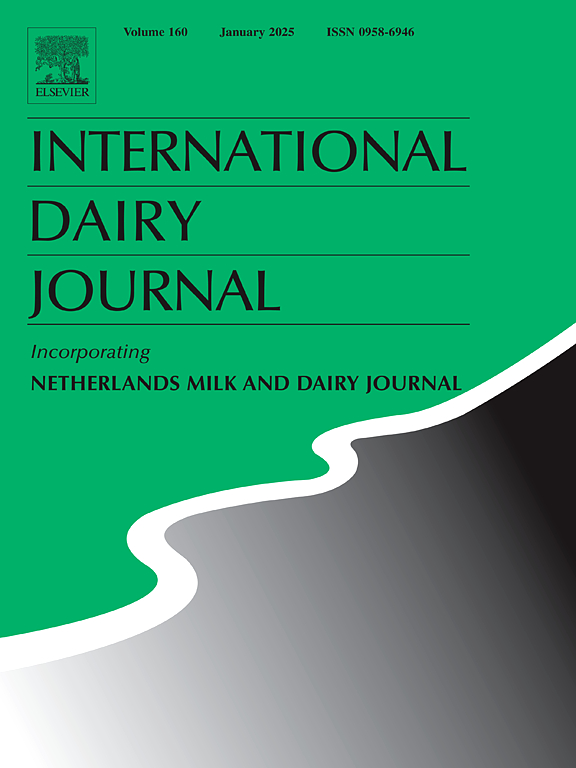多物种草地放牧制度和泌乳期对牛奶和切达奶酪加工效率和成分特性的影响
IF 3.4
3区 农林科学
Q2 FOOD SCIENCE & TECHNOLOGY
引用次数: 0
摘要
本研究调查了产奶中期和后期切达奶酪的生产过程,使用的牛奶来自生物多样性多种草(MSS)或多年生黑麦草(PRG)单一栽培。牛奶的宏观成分和脂肪酸谱大致相同,但与prg衍生牛奶相比,mss衍生牛奶的蛋白质和磷含量显著高于prg衍生牛奶,体细胞计数显著低于prg衍生牛奶。凝血酶凝血性能无显著差异,mss衍生奶酪具有典型的宏观成分。与PRG相比,MSS增加了奶酪产量;实际产量分别为11.13%和10.58%,水分调整后的脂肪和蛋白质产量分别为18.78%和18.25%。随着农业食品工业适应最大限度地提高效率和可持续性,需要进行调查,以预防任何可能对牛奶或产品质量造成的负面影响。因此,在这项研究中,MSS放牧似乎没有对牛奶加工成切达奶酪的效率产生不利影响。本文章由计算机程序翻译,如有差异,请以英文原文为准。
The impacts of a multispecies sward grazing system and stage of lactation on the processing-efficiency and compositional characteristics of milk and Cheddar cheese
This study investigated Cheddar cheese manufacturing, using milks derived from biodiverse multispecies swards (MSS) or perennial ryegrass (PRG) monocultures, at mid- and late-lactation. The macro-composition and fatty-acid-profiles of milks were broadly equivalent, but MSS-derived milks had significantly higher protein and phosphorus contents, and significantly lower somatic cell counts, compared to PRG-derived milks. No significant differences in rennet coagulation properties were observed, and MSS-derived cheese had a typical macro-composition. Increased cheese yields resulted from MSS compared to PRG; actual yields of 11.13 % and 10.58 % respectively, and moisture-adjusted cheese yields adjusted for fat and protein of 18.78 % and 18.25 % respectively. As agri-food industries adapt to maximise efficiency and sustainability, investigations are required to pre-empt any possible negative consequence to milk or product quality. As such, within this study, MSS grazing did not appear to adversely impact the processing-efficiency of milk into Cheddar.
求助全文
通过发布文献求助,成功后即可免费获取论文全文。
去求助
来源期刊

International Dairy Journal
工程技术-食品科技
CiteScore
6.50
自引率
9.70%
发文量
200
审稿时长
49 days
期刊介绍:
The International Dairy Journal publishes significant advancements in dairy science and technology in the form of research articles and critical reviews that are of relevance to the broader international dairy community. Within this scope, research on the science and technology of milk and dairy products and the nutritional and health aspects of dairy foods are included; the journal pays particular attention to applied research and its interface with the dairy industry.
The journal''s coverage includes the following, where directly applicable to dairy science and technology:
• Chemistry and physico-chemical properties of milk constituents
• Microbiology, food safety, enzymology, biotechnology
• Processing and engineering
• Emulsion science, food structure, and texture
• Raw material quality and effect on relevant products
• Flavour and off-flavour development
• Technological functionality and applications of dairy ingredients
• Sensory and consumer sciences
• Nutrition and substantiation of human health implications of milk components or dairy products
International Dairy Journal does not publish papers related to milk production, animal health and other aspects of on-farm milk production unless there is a clear relationship to dairy technology, human health or final product quality.
 求助内容:
求助内容: 应助结果提醒方式:
应助结果提醒方式:


